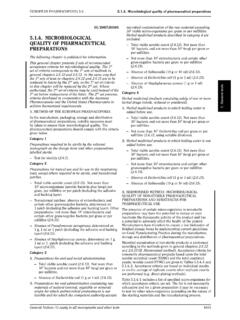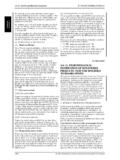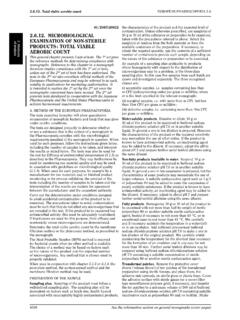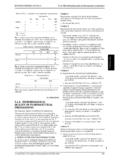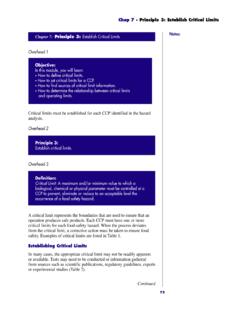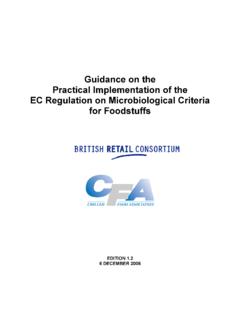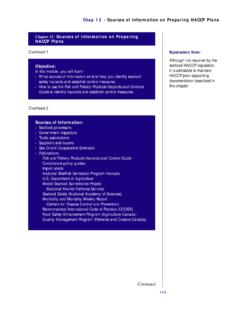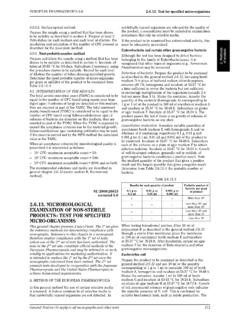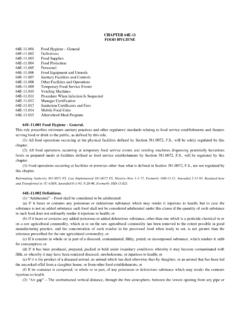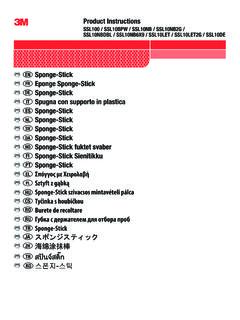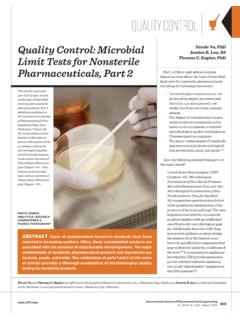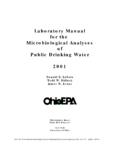Transcription of 2.6.13. MICROBIOLOGICAL EXAMINATION OF NON-STERILE ...
1 Test for specified micro-organismsEUROPEAN PHARMACOPOEIA materials used as active substances where samplequantity is limited or batch size is extremely small ( lessthan 1000 ml or 1000 g), the amount tested shall be 1 percent of the batch unless a lesser amount is prescribed orjustified and products where the total number of entities in a batchis less than 200 ( samples used in clinical trials), thesample size may be reduced to 2 units, or 1 unit if the sizeis less than the sample(s) at random from the bulk material orfrom the available containers of the preparation. To obtainthe required quantity, mix the contents of a sufficientnumber of containers to provide the OF THE filtrationUse a filtration apparatus designed to allow the transfer has been shown suitable as described in section 4 andtransfer the appropriate amount to each of 2 membranefilters and filter immediately. Wash each filter following theprocedure shown to be the determination of TAMC, transfer one of themembrane filters to the surface of casein soya bean digestagar.
2 For the determination of TYMC, transfer the othermembrane to the surface of Sabouraud-dextrose the plate of casein soya bean digest agar at30-35 Cfor3-5daysandtheplateofSabouraud-dextro seagar at 20-25 C for 5-7 days. Calculate the number of examining transdermal patches, filter 10 per centof the volume of the preparation described under 4-5-1separately through each of 2 sterile filter one membrane to casein soya bean digest agar forTAMC and the other membrane to Sabouraud-dextrose agarfor methods5-2-2-1. Pour-plate the sample using a method that has been shown to besuitable as described in section 4. Prepare for each mediumat least 2 Petri dishes for each level of dilution. Incubate theplates of casein soya bean digest agar at 30-35 C for 3-5 daysand the plates of Sabouraud-dextrose agar at 20-25 C for5-7 days. Select the plates corresponding to a given dilutionand showing the highest number of colonies less than 250for TAMC and 50 for TYMC. Take the arithmetic mean perculture medium of the counts and calculate the number ofCFU per gram or per millilitre of Surface-spread the sample using a method that has been shownto be suitable as described in section 4.
3 Prepare at least 2 Petri dishes for each medium and each level of dilution. Forincubation and calculation of the number of CFU proceed asdescribed for the pour-plate methodPrepare and dilute the sample using a method that has beenshown to be suitable as described in section 4. Incubate alltubes at 30-35 C for 3-5 days. Subculture if necessary, dilution the number of tubes showing microbial the most probable number of micro-organismspergramormillilitreofthep roducttobeexaminedfromTable OF THE RESULTSThe total aerobic microbial count (TAMC) is considered to beequal to the number of CFU found using casein soya beandigest agar; if colonies of fungi are detected on this medium,they are counted as part of the TAMC. The total combinedyeasts/mould count (TYMC) is considered to be equal to thenumber of CFU found using Sabouraud-dextrose agar; ifcolonies of bacteria are detected on this medium, they arecounted as part of the TYMC. When the TYMC is expected toexceedtheacceptancecriterionduetotheba cterialgrowth,Sabouraud-dextrose agar containing antibiotics may be the count is carried out by the MPN method the calculatedvalue is the an acceptance criterion for MICROBIOLOGICAL quality isprescribed it is interpreted as follows: 101 CFU: maximum acceptable count = 20; 102 CFU: maximum acceptable count = 200; 103 CFU: maximum acceptable count = 2000, and so recommended solutions and media are described ingeneral (under section B, Harmonisedmethod).
4 01/2007 MICROBIOLOGICALEXAMINATION OF NON-STERILEPRODUCTS: TEST FOR SPECIFIEDMICRO-ORGANISMSThis general chapter presents 2 sets of tests. The 1stset givesthe reference methods for determining compliance withmonographs. Reference to this chapter in a monographtherefore implies compliance with the 1stset of tests,unless use of the 2ndset of tests has been authorised. Thetests in the 2ndset also constitute official methods of theEuropean Pharmacopoeia and may be referred to as such,notably in applications for marketing authorisation. Itis intended to replace the 1stset by the 2ndset once themonographs concerned have been revised. The 2ndsetpresents tests developed in co-operation with the JapanesePharmacopoeia and the United States Pharmacopeia toachieve harmonised METHOD OF THE EUROPEAN PHARMACOPOEIAIn this general method the use of certain selective mediais proposed. A feature common to all selective media isthat sub-lethally injured organisms are not detected.
5 Assub-lethally injured organisms are relevant for the quality ofthe product, a resuscitation must be included in examinationprocedures that rely on selective the product to be examined has antimicrobial activity, thismust be adequately and certain other gram-negative bacteriaAlthough the test has been designed to detect bacteriabelonging to the family of Enterobacteriaceae, it isrecognised that other types of organisms ( ,Pseudomonas) may be of bacteria. Prepare the product to be examinedas described in the general ,butusingbrothmedium D in place of buffered sodium chloride-peptonesolution pH , homogenise and incubate at 35-37 C fora time sufficient to revive the bacteria but not sufficientto encourage multiplication of the organisms (usually 2 hbut not more than 5 h). Shake the container, transfer thequantity of the contents (homogenate A) corresponding to4404 See the information section on general monographs (cover pages)EUROPEAN PHARMACOPOEIA Test for specified micro-organisms1 g or 1 ml of the product to 100 ml of enrichment medium Eand incubate at 35-37 C for 18-48 h.
6 Subculture on platesof agar medium F. Incubate at 35-37 C for 18-24 h. Theproduct passes the test if there is no growth of colonies ofgram-negative bacteria on any evaluation. Inoculate suitable quantities ofenrichment broth medium E with homogenate A and/ordilutions of it containing respectively g, g ( , )oftheproducttobe examined. Incubate at 35-37 C for 24-48 h. Subcultureeach of the cultures on a plate of agar medium F to obtainselective isolation. Incubate at 35-37 C for 18-24 h. Growthof well-developed colonies, generally red or reddish, ofgram-negative bacteria constitutes a positive result. Notethe smallest quantity of the product that gives a positiveresult and the largest quantity that gives a negative from Table the probable number for each quantity of g g g mlProbable number ofbacteria per gramof product+++More than 103++ Less than 103andmore than 102+ Less than 102andmore than 10 Less than 10 When testing transdermal patches, filter 50 ml ofpreparation B as described in the general a sterile filter membrane, place the membranein 100 ml of enrichment broth medium E and incubateat 35-37 C for 18-24 h.
7 After incubation, spread on agarmedium F for the detection of Enterobacteria and othergram-negative coliPrepare the product to be examined as described in thegeneral use 10 ml or the quantitycorrespondingto1gor1mltoinoculat e100mlofbrothmedium A, homogenise and incubate at 35-37 C for 18-48 the container, transfer 1 ml to 100 ml of brothmedium G and incubate at 43-45 C for 18-24 h. Subcultureon plates of agar medium H at 35-37 C for 18-72 h. Growthof red, non-mucoid colonies of gram-negative rods indicatesthepossiblepresenceofE. biochemical tests, such as indole production. Theproduct passes the test if such colonies are not seen or if theconfirmatory biochemical tests are the product to be examined as described in thegeneral , but using broth medium A inplace of buffered sodium chloride-peptone solution pH ,homogenise and incubate at 35-37 C for 18-24 h. Transfer1mloftheenrichmentcultureto10mlo fbrothmediumIand incubate at 41-43 C for 18-24 h. Subculture on at least2 different agar media chosen from among agar medium J,agar medium K and agar medium L.
8 Incubate at 35-37 C for18-72 h. The probable presence of salmonellae is indicatedby the growth of cultures having the following appearance: agarmediumJ:well-developed, colourless colonies; agarmediumK:well-developed, red colonies, with orwithout black centres; agarmediumL:small, transparent, colourless or pink oropaque-white colonies, often surroundedby a pink or red separately a few of the suspect colonies to agarmedium M in tubes, using surface and deep inoculation. Thepresence of salmonellae is provisionally confirmed if in thedeep inoculation but not in the surface culture there is achange of colour from red to yellow and usually a formationof gas, with or without production of hydrogen sulphidein the agar. Precise confirmation may be carried out byappropriate biochemical and serological tests. The productpasses the test if colonies of the type described do not appearor if the confirmatory biochemical and serological tests aeruginosaPrepare the product to be examined as described in thegeneral use 10 ml or the quantitycorresponding to 1 g or 1 ml to inoculate 100 ml ofbroth medium A, homogenise and incubate at 35-37 Cfor 18-48 h.
9 Subculture on a plate of agar medium Nand incubate at 35-37 C for 18-72 h. If no growth ofmicro-organisms is detected, the product passes the test. Ifgrowth of gram-negative rods occurs, transfer some materialof morphologically different, isolated colonies to brothmedium A and incubate at 41-43 C for 18-24 h. The productpasses the test if no growth occurs at 41-43 testing transdermal patches, filter 50 ml ofpreparation A as described in the general a sterile filter membrane and place in 100 ml ofbroth medium A and incubate at 35-37 C for 18-48 h. Afterincubation, spread on agar medium aureusPrepare the product to be examined as described in thegeneral use 10 ml or the quantitycorresponding to 1 g or 1 ml to inoculate 100 ml ofbroth medium A, homogenise and incubate at 35-37 Cfor 18-48 h. Subculture on a plate of agar medium Oand incubate at 35-37 C for 18-72 h. Black colonies ofgram-positive cocci surrounded by a clear zone indicatethe presence ofS.
10 Aureus. Confirmation may be effectedby suitable biochemical tests such as the coagulase testand the deoxyribonuclease test. The product passes thetest if colonies of the type described do not appear on agarmedium O or if the confirmatory biochemical tests testing transdermal patches, filter 50 ml ofpreparation A as described in the general a sterile filter membrane and place in 100 ml ofbroth medium A and incubate at 35-37 C for 18-48 h. Afterincubation, spread on agar medium and selective properties of the media and validityof the testThe tests described hereafter must be performed at least oneach lot of dehydrated as follows. Grow the following test strainsseparately, in tubes containing suitable media such as thoseindicated, at 30-35 C for 18-24 h:Staphylococcus aureussuch as ATCC 6538 (NCIMB 9518, CIP ):broth medium A;Pseudomonas aeruginosasuch as ATCC 9027 (NCIMB 8626, CIP ):broth medium A;Escherichia colisuch as ATCC 8739 (NCIMB 8545, CIP ):broth medium A;Salmonella typhimuriumno strain number is recommended (asalmonella not pathogenic for man, such asSalmonella abony(NCTC 6017, CIP ),may also be used): broth medium portions of each of the cultures using bufferedsodium chloride-peptone solution pH to make testsuspensions containing about 1000 viable micro-organismsGeneralNotices(1) Test for specified micro-organismsEUROPEAN PHARMACOPOEIA millilitre.
